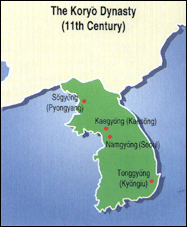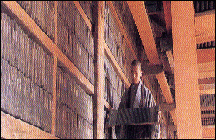KOREA>HISTORY>Koryo
![]()
5. Koryo
 The
founder of Koryo (918-1392) was a general who had served under a rebel
prince of Shilla. Choosing his native town, Songak, as the capital of his
dynasty, he proclaimed a policy to recover the lost territory of Koguryo in
Manchuria. Therefore he named his dynasty Koryo, from which the modern name
Korea is derived. The
founder of Koryo (918-1392) was a general who had served under a rebel
prince of Shilla. Choosing his native town, Songak, as the capital of his
dynasty, he proclaimed a policy to recover the lost territory of Koguryo in
Manchuria. Therefore he named his dynasty Koryo, from which the modern name
Korea is derived. Koryo consolidated control over the peninsula and strengthened its political and economic foundations. A new system of laws and government, modeled after China's laws and government, was established, and Buddhism, which had come to Korea from China in 372, was made the official religion. Koryo made outstanding accomplishments in several cultural areas. Korean potters created a mysterious bluish green glaze for celadons, or bluish-green porcelains, considered by many specialists to be the best in the world, surpassing even the Chinese porcelains upon which they were originally modeled. No less significant was the invention of the world's first movable metal type in 1234, which preceded Gutenberg by two centuries. About this time, Korean technicians also completed the carving the entire Buddhist canon on large woodblocks. These woodblocks, numbering no less than 80,000, were intended to invoke the influence of Buddha for the repulsion of the Mongol invaders. Called Tripitaka Koreana, they are now stored at the historic Haein Temple.  From
the outset, the Koryo court adopted Buddhism as the state religion. It
flourished greatly, stimulating temple construction and the carving of
Buddha images as well as icon paintings. But it also played a part in the
decline of the Koryo court, as monks wielded excessive power. Power
struggles and avariciousness among the ruling classes led to revolts by
their subjects. The situation was aggravated by the rise in the north of the
Mongols, who launched a massive invasion in 1231. The Koryo armies put up
fierce resistance but were no match for the highly organized mounted troops
from the north, whose forces swept most of the Eurasian continent during
this period. The Mongol incursions left Koryo as a Mongol vassal state for
nearly a century despite courageous resistance from the Koryo people for
over 20 years. From
the outset, the Koryo court adopted Buddhism as the state religion. It
flourished greatly, stimulating temple construction and the carving of
Buddha images as well as icon paintings. But it also played a part in the
decline of the Koryo court, as monks wielded excessive power. Power
struggles and avariciousness among the ruling classes led to revolts by
their subjects. The situation was aggravated by the rise in the north of the
Mongols, who launched a massive invasion in 1231. The Koryo armies put up
fierce resistance but were no match for the highly organized mounted troops
from the north, whose forces swept most of the Eurasian continent during
this period. The Mongol incursions left Koryo as a Mongol vassal state for
nearly a century despite courageous resistance from the Koryo people for
over 20 years. As the Mongols retreated to the north and the Ming established a garrison in the northeastern part of the Korean Peninsula, the Koryo court was torn between pro-Ming and pro-Mongol factions. General Yi Song-gye, who had been sent to attack the Ming forces in the Liaodong region of Manchuria, revolted at the Amnok River and turned his army against his own capital, seizing it with ease. Yi took the throne in 1392, founding Korea's most enduring dynasty, Choson. The capital of Choson was at Seoul. |
